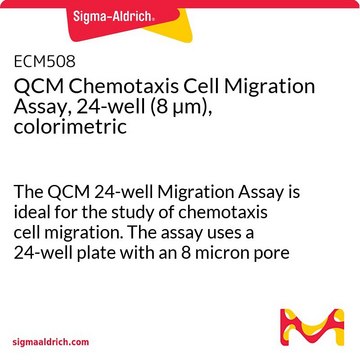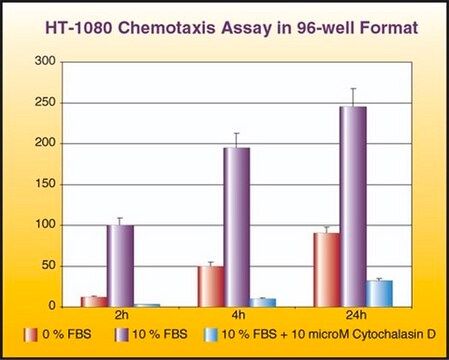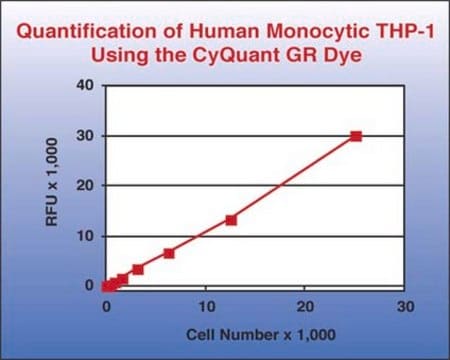ECM509
QCM Chemotaxis Cell Migration Assay, 24-well (8 µm), fluorimetric
The QCM 24-well Migration Assay is ideal for the study of chemotaxis cell migration. The assay uses a 24-well plate with an 8 micron pore size, with fluorescent detection.
Synonim(y):
cell migration assay, fluorometric chemotaxis assay
Zaloguj sięWyświetlanie cen organizacyjnych i kontraktowych
About This Item
Kod UNSPSC:
12352207
eCl@ss:
32161000
NACRES:
NA.32
Polecane produkty
Poziom jakości
reaktywność gatunkowa (przewidywana na podstawie homologii)
all
producent / nazwa handlowa
Chemicon®
QCM
metody
activity assay: suitable
cell based assay: suitable
metoda wykrywania
fluorometric
Warunki transportu
wet ice
Zastosowanie
Research Category
Cell Structure
Cell Structure
The CHEMICON® QCM 24-well Migration Assay is ideal for the study of chemotaxis cell migration. Each Chemicon Cell Migration Assay Kit contains sufficient reagents for the evaluation of 24 samples. The quantitative nature of this assay is especially useful for screening of pharmacological agents.
The CHEMICON QCM 24-well Migration Assay is intended for research use only; not for diagnostic applications.
The CHEMICON QCM 24-well Migration Assay is intended for research use only; not for diagnostic applications.
The QCM 24-well Migration Assay is ideal for the study of chemotaxis cell migration. The assay uses a 24-well plate with an 8 micron pore size, with fluorescent detection.
Opakowanie
24 wells
Komponenty
Sterile 24-well Cell Migration Plate Assembly: (Part No. 90333) Two 24-well plates with 12 inserts per plate (24 inserts total/kit).
Cell Detachment Solution: (Part No. 90131) One bottle - 16 mL.
4X Cell Lysis Buffer: (Part No. 90130) One bottle - 16 mL.
CyQUANTâ GR Dye1: (Part No. 90132) One vial - 75 μL
Forceps: (Part No. 10203) One each.
Cell Detachment Solution: (Part No. 90131) One bottle - 16 mL.
4X Cell Lysis Buffer: (Part No. 90130) One bottle - 16 mL.
CyQUANTâ GR Dye1: (Part No. 90132) One vial - 75 μL
Forceps: (Part No. 10203) One each.
Przechowywanie i stabilność
Store kit materials at 2-8°C for up to their expiration date. Do not freeze.
Informacje prawne
CHEMICON is a registered trademark of Merck KGaA, Darmstadt, Germany
Oświadczenie o zrzeczeniu się odpowiedzialności
Unless otherwise stated in our catalog or other company documentation accompanying the product(s), our products are intended for research use only and are not to be used for any other purpose, which includes but is not limited to, unauthorized commercial uses, in vitro diagnostic uses, ex vivo or in vivo therapeutic uses or any type of consumption or application to humans or animals.
Ta strona może zawierać tekst przetłumaczony maszynowo.
Hasło ostrzegawcze
Danger
Zwroty wskazujące rodzaj zagrożenia
Zwroty wskazujące środki ostrożności
Klasyfikacja zagrożeń
Aquatic Acute 1 - Aquatic Chronic 2 - Eye Dam. 1
Kod klasy składowania
10 - Combustible liquids
Certyfikaty analizy (CoA)
Poszukaj Certyfikaty analizy (CoA), wpisując numer partii/serii produktów. Numery serii i partii można znaleźć na etykiecie produktu po słowach „seria” lub „partia”.
Masz już ten produkt?
Dokumenty związane z niedawno zakupionymi produktami zostały zamieszczone w Bibliotece dokumentów.
Yukuan Feng et al.
European journal of cancer (Oxford, England : 1990), 47(15), 2353-2363 (2011-06-18)
Vascular endothelial growth factor C (VEGF-C) expression is associated with the malignant tumour phenotype making it an attractive therapeutic target. We investigated the biological roles of VEGF-C in tumour growth, migration, invasion and explored the possibility of VEGF-C as a
Santosh Kumar Guru et al.
Cancer research, 75(14), 2886-2896 (2015-05-16)
Tumor angiogenesis is a validated target for therapeutic intervention, but agents that are more disease selective are needed. Here, we report the isolation of secalonic acid-D (SAD), a mycotoxin from a novel source that exhibits potent antiangiogenic antitumor activity. SAD
Dang Chao et al.
Oncology reports, 45(6) (2021-04-14)
Stomatin‑like protein 2 (SLP‑2) is associated with poor prognosis in several types of cancer, including pancreatic cancer (PC); however, the molecular mechanism of its involvement remains elusive. The present study aimed to elucidate the role of this protein in the development
Colleen T Skau et al.
Cell, 167(6), 1571-1585 (2016-11-15)
Cell migration in confined 3D tissue microenvironments is critical for both normal physiological functions and dissemination of tumor cells. We discovered a cytoskeletal structure that prevents damage to the nucleus during migration in confined microenvironments. The formin-family actin filament nucleator
Nasz zespół naukowców ma doświadczenie we wszystkich obszarach badań, w tym w naukach przyrodniczych, materiałoznawstwie, syntezie chemicznej, chromatografii, analityce i wielu innych dziedzinach.
Skontaktuj się z zespołem ds. pomocy technicznej










